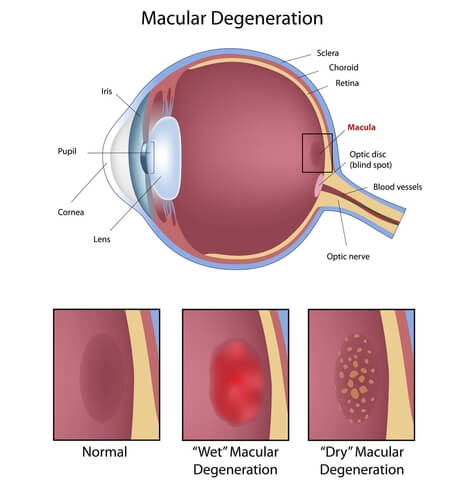There are a few age-related eye conditions that are more common than others. One of those conditions is macular degeneration, specifically age-related macular degeneration, or AMD.
Age-related macular degeneration is an eye condition that affects older adults, making it essential to be aware of it. If you’re an adult over 40, you should have regular eye exams so any eye diseases can be diagnosed and promptly treated.
However, treatment isn’t always viable regarding age-related macular degeneration. The good news is that there are options, and having your AMD diagnosed as early as possible is still important.
Keep reading to understand better what age-related macular degeneration is, how it can affect your vision, and how to treat it in some cases.
What is Age-Related Macular Degeneration?

Macular degeneration happens when the macula, the center of the retina, becomes thinner. The retina is the thin membrane that lines the back of your eye and contains photoreceptor cells that translate the light that passes through your eye into impulses sent to your brain.
When the retina is damaged, these photoreceptor cells die, so they can’t translate all the light that passes through your eye. Since the macula is the retina’s center, it causes vision loss in the center of your visual field if it suffers any damage. In very rare cases, it can even lead to complete blindness.
Age-related macular degeneration (AMD) is the most common kind of macular degeneration. You’re at higher risk for age-related macular degeneration if you:

- Are 60 or older
- Are Caucasian
- Are a smoker
- Have a family history of age-related macular degeneration
Like many age-related eye conditions, the symptoms of age-related macular degeneration aren’t often apparent until they become severe. There are a few early symptoms you can look out for, although they’re different for the two different kinds of age-related macular degeneration: Dry and wet.
Dry Vs. Wet Age-Related Macular Degeneration
There are two different kinds of age-related macular degeneration. Between the two, dry is far more common. However, dry macular degeneration may eventually develop into a rarer form of macular degeneration, wet AMD.
Dry Age-Related Macular Degeneration is the most common kind of age-related macular degeneration. It’s caused by a buildup of yellowish deposits called drusen in the retina.
The more drusen that develop in your macula, the more the macula begins to thin out. Luckily, the visual symptoms of dry age-related macular degeneration often remain mild.

The early symptoms of dry age-related macular degeneration are usually just difficulties reading. However, you should have your eyes examined regularly so any signs of drusen in your retina can be spotted early and monitored.
Dry age-related macular degeneration may remain mild, but it can also develop into wet AMD, which is more severe.
Wet Age-Related Macular Degeneration is caused by the abnormal growth of blood vessels under the retina. These blood vessels swell and leak, damaging the macula as scar tissue builds up.
The early symptoms of wet age-related macular degeneration are visual distortion and blindness in the center of your vision. Unfortunately, though, these symptoms are irreversible and permanent when they are present.
The damage age-related macular degeneration does to your vision is permanent. This is why it’s crucial to diagnose your macular degeneration before you develop any symptoms so it can be monitored and treated effectively.
Treating Age-Related Macular Degeneration
It’s challenging to treat age-related macular degeneration. There’s no cure for either form of macular degeneration.
However, treatments can slow down its progression and even prevent vision loss. Treatment differs depending on which kind of age-related macular degeneration you have.
Dry Age-Related Macular Degeneration Treatment

Treatment for dry age-related macular degeneration is unfortunately limited. Currently, there’s no way to treat age-related macular degeneration to prevent the buildup of drusen.
But it’s still necessary to be diagnosed and monitored, especially because dry age-related macular degeneration can develop into wet AMD. There also may be a way to lower the risk of dry AMD turning into wet AMD.
A clinical study called the AREDS2 study tested the daily use of vitamins A, C, and E for dry AMD. The study intended to determine if taking these vitamins would reduce the likelihood of patients developing wet age-related macular degeneration from having dry AMD.
As it turned out, patients in the study with dry AMD did appear to be less likely to develop wet AMD. Because of these, many eye doctors prescribe vitamins A, C, and E for patients with dry AMD, as it may lower their risk of dry macular degeneration turning into wet AMD.
Wet Age-Related Macular Degeneration Treatment
There are a few ways to treat wet age-related macular degeneration to prevent further vision loss. In addition to monitoring your condition, your ophthalmologist may give you anti-VEGF injections.
These injections inhibit vascular endothelial growth factor (VEGF), the protein that stimulates new blood vessel growth. By inhibiting VEGF, the injections stop new blood vessel growth, preventing more from forming under the macula. These injections usually need to be taken regularly to remain effective.
There are also laser treatments available to treat wet age-related macular degeneration. These treatments use photocoagulation to seal leaking blood vessels in the retina, shrinking them and preventing the buildup of scar tissue.
If you have wet age-related macular degeneration, your eye doctor may recommend anti-VEGF injections or laser treatment. Still, they may recommend a combination of both depending on the severity of your condition.
Do you need treatment for age-related macular degeneration? Request an appointment at New England Eye Center in Boston, MA!
